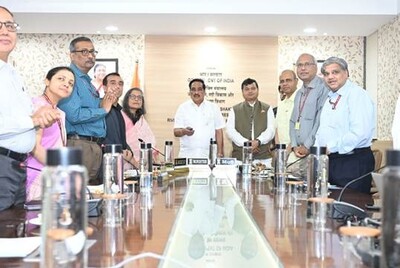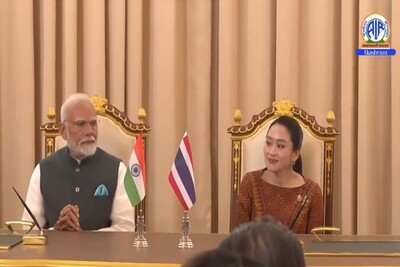Daily Current Affairs and GK | 4 April 2025

Main Headlines:
- 1. International Day for Mine Awareness 2025: 4 April
- 2. A powerful earthquake struck Kyushu region of Japan on April 2.
- 3. Indian Yoga Association joined in the grand celebration of International Yoga Day 2025.
- 4. Water Resource Census application and portal and Web-Based Reservoir Storage Monitoring System launched in New Delhi.
- 5. On 4 April, the Waqf (Amendment) Bill 2025 passed by Parliament after being approved by the Rajya Sabha.
- 6. India and Thailand signed six agreements in various sectors.
- 7. As of now, concept design for the first Bharat Small Modular Reactor (BSMR) 200 MWe has been finalized.
- 8. Global Engagement Scheme is being implemented by Ministry of Culture.
- 9. On April 3, 2025, Raksha Mantri Shri Rajnath Singh launched expeditions to Mount Everest and Mount Kangchenjunga.
- 10. Union Home Minister Amit Shah introduced a statutory resolution in the Lok Sabha.
Happy December get 35% Off
Use Coupon code DEC25
Topic: Important Days
1. International Day for Mine Awareness 2025: 4 April
- Every year on 4 April, the International Day for Mine Awareness is observed.
- It is celebrated to increase public attention towards mine action activities, land mines, their threats to the safety of mankind, and how to work towards their eradication.
- The theme of the International Day for Mine Awareness 2025 is “Safe Futures Start Here.”
- On 8th December 2005, the United Nations General Assembly confirmed that the 4th of April of every year would be observed as International Day for Mine Awareness and Assistance in Mine Action.
- It was first observed on 4th April, 2006.
- The day calls for efforts from national leaders to create and develop national mine-action capacities.
- Daniel Craig was the first UN Advocate for the Elimination of Mines and Explosive Hazards.
- More than 100 million people worldwide are at risk from landmines, explosive remnants of war and improvised explosive devices.
Topic: Geography
2. A powerful earthquake struck Kyushu region of Japan on April 2.
- The earthquake measured 6.0 on the Richter scale.
- The earthquake occurred 30 kilometers deep as per National Center for Seismology.
- Its epicenter was at Latitude 31.09 N and Longitude 131.47 E.
- Japan frequently experiences earthquakes due to its location on the Pacific Ring of Fire.
- This earthquake in Japan follows shortly after a deadly earthquake in Myanmar.
- On 28 March 2025, earthquake struck Myanmar’s Sagaing Region. Its epicenter was close to Mandalay.
- It was the strongest earthquake to strike Myanmar since 1912.
- Kyushu is the third-largest island of four main islands of Japan. Japan's most active volcano, Mount Aso, is on Kyushu.
- The Pacific Ring of Fire is the meeting point of many tectonic plates, a region with intense seismic activity.
Topic: National News
3. Indian Yoga Association joined in the grand celebration of International Yoga Day 2025.
- The Indian Yoga Association (IYA) has stepped forward to actively participate in the celebrations of International Day of Yoga (IDY) 2025, with just 79 days remaining.
- IYA representatives from 27 state chapters actively participated in the discussion and demonstrated their dedication and enthusiasm towards the mega International Yoga Day 2025.
- The Ministry of AYUSH thanked IYA for their proactive approach and presenting advance planning for IDY 2025.
- This collaboration is expected to promote the festival and help spread the benefits of yoga globally.
- The theme of IDY 2025 is “Yoga for One Earth One Health”.
- According to IYA members, many have already formulated specific plans to organize activities for the 10 unique signature events designed to celebrate the 10th anniversary of International Day of Yoga 2025.
- These are the 10 major events:
|
No. |
Initiative |
|
1. |
Yoga Sangam |
|
2. |
Yoga Bandhan |
|
3. |
Yoga Parks |
|
4. |
Yoga Samavesh |
|
5. |
Yoga Prabhav |
|
6. |
Yoga Connect |
|
7. |
Harit Yoga |
|
8. |
Yoga Unplugged |
|
9. |
Yoga Maha Kumbh |
|
10. |
Samyoga |
Topic: Government Schemes and Initiatives
4. Water Resource Census application and portal and Web-Based Reservoir Storage Monitoring System launched in New Delhi.
- The Water Resource Census application and portal were launched by Union Minister of Jal Shakti Shri C.R. Patil.
- Water Resources Census Application and Portal supports the following census schemes:
- 7th Minor Irrigation Census
- 2nd Census of Water Bodies
- 1st Census of Springs
- 1st Census of Major and Medium Irrigation Projects
- This is a 100% centrally sponsored scheme launched under the Irrigation Census Scheme, the reference year of which will be the agricultural year 2023-24 (July 2023 – June 2024).
- The main objective of the Water Resources Census is to build a comprehensive and reliable database for effective planning and policy making in the irrigation sector including water use efficiency, water budgeting etc.
- Apart from this, on 3 April, the Web-Based Reservoir Storage Monitoring System (RSMS) Portal was also launched by Shri C.R. Patil.
- The Central Water Commission monitors the Live storage capacity of 161 important reservoirs in the country and issues weekly bulletin every Thursday.
- The total storage capacity of these reservoirs in FRL is 182.375 BCM which is about 70.74% of the estimated total storage capacity in the country.
- This bulletin is sent to PMO, NITI Aayog, MoJS, MoP, MoA&FW, IMD, Disaster Management Authorities and all concerned States and also uploaded on the CWC website.
- The present system involves manually preparing various graphs, charts and tables etc. for inclusion in the bulletin.
- However, the new portal involves all the necessary data analysis and issuance of final bulletin including preparation of maps, tables, graphs, etc. and will be done automatically by clicking on a button once the data is entered into the portal.
- Also, through this portal the general public can access information about the storage status of a particular reservoir or any state or country.

(Source: PIB)
Topic: Indian Polity
5. On 4 April, the Waqf (Amendment) Bill 2025 passed by Parliament after being approved by the Rajya Sabha.
- The Upper House approved the bill, with 128 members voting in favour and 95 against it. The Lok Sabha has already approved the bill.
- The Mussalman Wakf (Repeal) Bill, 2025, which repeals the Mussalman Wakf Act, 1923, was also approved by Parliament after being passed by the Rajya Sabha.
- The aim of this bill is to streamline the management of waqf properties with provisions for protecting heritage sites and promoting social welfare.
- Additionally, the aim of the bill is to improve governance by increasing transparency in property management, streamlining coordination between Waqf Boards and local authorities, and protecting the rights of stakeholders.
- According to the bill, the mandatory contribution of Waqf institutions to the Waqf Boards has been reduced from 7% to 5%, and Waqf institutions with income of more than Rs 1 lakh will be audited by state-sponsored auditors.
- A centralised portal will automate waqf property management, improving efficiency and transparency.
- The bill proposes that Muslims of religious faith can dedicate their property to Waqf (for a minimum period of five years), thereby restoring the pre-2013 rules.
- It provides that women should receive their inheritance even before the wakf declaration, and makes special provisions for widows, divorced women and orphans.
- The Bill proposes that an officer above the rank of Collector will investigate government properties claimed as Waqf.
- It also proposed that non-Muslim members should also be included in the Central and State Waqf Boards for inclusiveness.
- 'Waqf' is defined by Muslim law as the permanent dedication by any person of any movable or immovable property for any purpose recognised as pious, religious or charitable.
- The history of Waqf legislation in India:
|
Act/Bill |
Key Features / Importance |
|
Mussalman Wakf Validating Act, 1913 |
|
|
Mussalman Wakf Act, 1923 |
|
|
Mussalman Wakf Validating Act, 1930 |
|
|
Waqf Act, 1954 |
|
|
Amendments to the Wakf Act, 1954 (1959, 1964, 1969, and 1984) |
|
|
Waqf Act, 1995 |
|
|
Waqf (Amendment) Act, 2013 |
|
|
Waqf (Amendment) Bill, 2025 |
|
|
Mussalman Wakf (Repeal) Bill, 2024 |
|
Topic: MoUs and Agreements
6. India and Thailand signed six agreements in various sectors.
- On 3 April, six agreements were signed between India and Thailand for cooperation in various fields including IT, maritime, MSME, handicraft and handloom sectors.
- These agreements were signed after bilateral talks between Prime Minister Narendra Modi and his Thai counterpart Patongtarn Shinawatra in Bangkok.
- This was their second meeting, the first being during the ASEAN-related summit in Vientiane in October 2024.
- PM Modi was on a two-day visit to Thailand to attend the 6th BIMSTEC Summit to be held on April 4.
- Both sides reviewed bilateral ties, explored ways to strengthen the India-Thailand partnership, and exchanged views on regional and global issues.
- Both sides emphasized cooperation in the fields of tourism, culture and education between North-East India and Thailand.
- India and Thailand are maritime neighbours with shared civilisational bonds stretching back to cultural, linguistic and religious ties, including links between the Ramayana and Buddhism.
- The relationship between India and Thailand is a vital component of India’s ‘Act East’ Policy, Comprehensive Strategic Partnership with ASEAN, Vision Metropolis and our vision of the Indo-Pacific.
- Continuous interaction between the two countries has given rise to a strong and multi-faceted relationship based on centuries-old ties and shared interests.
- After the BIMSTEC Summit, Prime Minister Modi is on a three-day State visit to Sri Lanka from 4 April at the invitation of Sri Lankan President Anura Kumara Dissanayake.

(Source: News on AIR)
Topic: Science and Technology
7. As of now, concept design for the first Bharat Small Modular Reactor (BSMR) 200 MWe has been finalized.
- It includes reactor sizing and the primary heat transport system.
- The construction and initiation of the demonstration unit are will take 6 years after receiving financial approval.
- Operational readiness will be achievable by the 7th year.
- The projected cost for the lead unit is ₹5,700 Crores.
- The development of BSMR is led by BARC and NPCIL.
- Private indigenous nuclear vendors will be selected through competitive bidding.
- They will provide various components and equipment.
- BSMR utilizes globally recognized pressurized water reactor technology.
- It includes passive safety features and engineered safety systems.
- The nuclear safety of the BSMR plant will be thoroughly reviewed.
- It will undergo a rigorous regulatory licensing process.
- Efforts will be made to standardize designs for future units.
- BSMR will primarily rely on domestic resources to ensure long-term sustainability and wide-scale implementation.
- The use of slightly enriched imported uranium may be considered if necessary.
Topic: Government Schemes and Initiatives
8. Global Engagement Scheme is being implemented by Ministry of Culture.
- This scheme is being implemented to enhance India's cultural presence worldwide and improve its global image.
- The scheme is implemented through Indian Missions abroad, covering various programs like the Festival of India.
- The Festival of India allows Indian artists from different cultural backgrounds to showcase their talents globally.
- Financial support is provided to Indo-Foreign Friendship Cultural Societies.
- The Indian Council for Cultural Relations (ICCR) spreads Indian culture internationally.
- In 2021, India hosted the BRICS Culture Senior Officers' and Culture Ministers' Meetings.
- In 2023, India organized the Conference on Shared Buddhist Heritage and the 20th SCO Culture Ministers' Meeting.
- India also held the inaugural India-Central Asia Culture Ministers Meeting in 2023.
- During its G20 presidency, India organized the G20 Culture Working Group and Culture Ministers’ Meeting in 2023.
- At the G20 Leaders’ Summit in New Delhi, India showcased the G20 Digital Museum and "Routes and Roots" exhibitions.
- India adheres to 1972 World Heritage Convention and the 2003 Intangible Cultural Heritage Convention.
- G20 Culture Working Group released Outcome Document titled the ‘Kashi Culture Pathway’.
- It advocated for culture as a standalone goal in post-2030 development agenda.
- India is also a part of 2005 Convention on the Protection and Promotion of the Diversity of Cultural Expressions, UNESCO Creative Cities Network (UCCN), and Memory of the World (MOW) Programme.
Topic: Defence
9. On April 3, 2025, Raksha Mantri Shri Rajnath Singh launched expeditions to Mount Everest and Mount Kangchenjunga.
- The Indian Army’s Mount Everest expedition consists of 34 climbers.
- They will follow the South Col Route and be led by Lieutenant Colonel Manoj Joshi.
- A joint Indo-Nepal team will attempt to scale Mount Kangchenjunga.
- The team includes 12 climbers from the Indian Army and 6 from the Nepali Army.
- The expedition will be led by Colonel Sarfaraz Singh.
- A joint NCC expedition to Mount Everest will also take place.
- This team will be led by Colonel Amit Bisht.
- The expeditions are set to begin this month. The climbers aim to reach their summits by May 2025.
- The expeditions will highlight India’s leadership in high-altitude mountaineering.
- The goal is to showcase the Armed Forces' skills, resilience, and spirit.
Topic: State News/Manipur
10. Union Home Minister Amit Shah introduced a statutory resolution in the Lok Sabha.
- He introduced the resolution to seek approval of the imposition of President's Rule in Manipur.
- The resolution was adopted by the House. Some people lost their lives in the violence in Manipur.
- The violence in Manipur was caused by a reservation dispute between two communities following a decision by the Manipur High Court.
- The Minister said that between 1993 and 1998, there was a Naga-Kuki conflict in Manipur.
- There has been no violence in the state for the past four months.
- From 2012 to 2017, Manipur experienced shutdowns averaging over 200 days per year.
- There was no ethnic violence during that period.
- Under BJP rule from 2017, there were no shutdowns or violence before the High Court's decision.
- Violence erupted within days of the High Court's order. Both communities misinterpreted the ruling.
- Shri Shah reassured that the government's priority is to restore peace.
- Providing rehabilitation to the affected people is also a priority.
- After the Chief Minister's resignation, the Governor engaged with political representatives.
- The Governor then recommended the imposition of President's Rule.
- The Cabinet’s recommendation for President's Rule was accepted by the President.
- Resolution and Statutory Resolution:
- A resolution can be moved by the members to attract the attention of the House or the government to issues of general public interest.
- Either a private member or a minister can move a statutory resolution. It is always tabled to carry out a provision in the Constitution.
- Violence in Manipur:
- Violence in Manipur started in May 2023 between Meitei people and Kuki community.
- In April 2023, an order about Scheduled Tribe status for Meitei people was passed by Manipur High Court. Protests and violence started.
- State Emergency, its process and duration:
- If there is a failure of constitutional machinery in the state, Article 356 of the Constitution provides for the Centre to take over the government of a state.
- This is popularly known as President’s rule. It is also called State Emergency.
- If the government of a state cannot be continued as per the provisions of the Constitution, the President makes an announcement of the President’s rule under Article 356.
- This can be done by the President either on the governor’s report or without the report of the governor of the state.
- Both Lok Sabha and Rajya Sabha must approve imposing of the President’s rule within two months from the date on which it was imposed.
- The President’s rule remains in force for six months if both Rajya Sabha and Lok Sabha approve it.
- With the approval of the Parliament, it may be extended every six months for a maximum of three years.
| Monthly Current Affairs eBooks | |
|---|---|
| February Monthly Current Affairs 2025 | January Monthly Current Affairs 2025 |
| December Monthly Current Affairs 2024 | October Monthly Current Affairs 2024 |





 3 April 2025 Current Affairs
3 April 2025 Current Affairs 








Comments